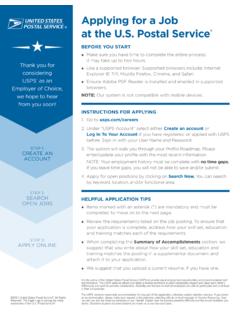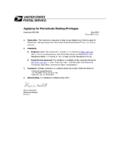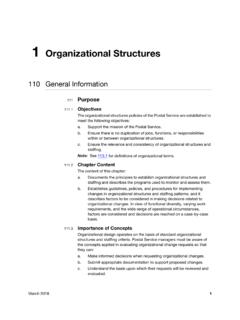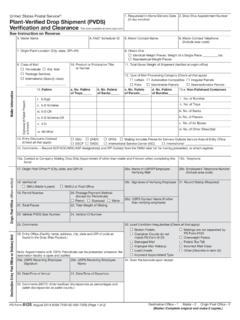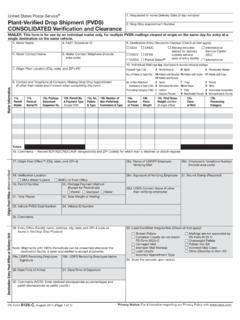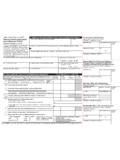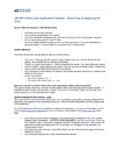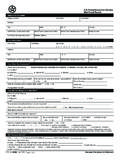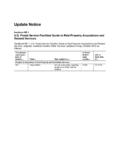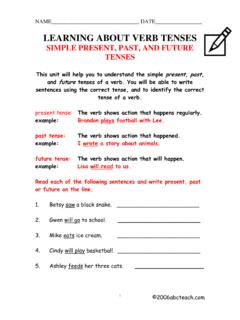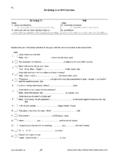Transcription of USPS Future Business Model
1 usps Future Business ModelMarch 2, 2010 McKinsey & Company1|Contents Recent context Base case minimal management actions Addressing the challenge Short term requirementsMcKinsey & Company2| usps is experiencing unprecedented losses SOURCE: usps ; 109-435 (PAEA) profit/loss$ billionsPostal Act 2006 signed into lawNote: All years in this document refer to Fiscal Years ending on Sept 301 Includes one-time $4 billion deferral2 Per 2010 Integrated Financial Plan (January Year-to-Date results are favorable to Plan) pre-funding,$ billionsKey drivers Revenue declines due to: E-diversion of First-Class Mail Down-trading from First-Class to Standard Mail Losses of advertising mail due to the recession RHB pre-funding requirement introduced by the PAEA Cost savings, while substantial, have been less than revenue declines due to high fixed costs of the networkNo rate increase 2003-2006 Recent ContextMcKinsey & Company3|Losses have been driven by volume declines, RHB pre-funding requirements and limitations on cost deferralCost pre-funding of change in net income 2006 vs.
2 2009$ billionsSOURCE: usps 2006 Annual Report; usps 2010 Budget1 Revenue declines calculating by applying 2009 prices against 2006-09 volume declines Volume declines of 17%, driven by E-substitution Ad spend shift to other channels Deep recession Savings driven by Reduction of overtime Extreme slow-down in hiring Route consolidation Volume reductionRecent ContextMcKinsey & Company4|Volume declines have been worse than expected when the current legal and regulatory framework was established24023022021020019018017016002 0100908070605042003 ActualUpside forecastDownsideforecastBase case forecastSOURCE: USPS2005forecasts2 When PAEA was passed, volume projections did not anticipate the current scale of declines PAEA introduced some additional product flexibility, but also two crucial restrictions.
3 Price increases capped at CPI by class Significant pre-funding requirements for Retiree Health Benefits (RHB)1 Postal Accountability and Enhancement Act, 20062 Forecasts from usps Strategic Transformation Plan , 2005 Volume forecasts and actualsBillions of piecesPAEA implications1 Recent ContextMcKinsey & Company5|First-Class Mail, Standard Mail and GDP growthCumulative increase from 1973, percentThe recession has exacerbated volume declines, but mail has reached an inflection point, with e-diversion now driving long term decline250150 Standard Mailvolume300100020052000199519901985198 01975 First-Class MailvolumeReal GDP20050350400 SOURCE: USPS2009 Recent ContextMcKinsey & Company6|Retiree Health Benefit funding requirements are a significant burden, equal to 12% of total revenue in 2010 RHB payments, 2006 2010$ billionSOURCE: usps 2009 10-K.
4 usps 2010 Pre-funding is unique to usps within the public sector, and rare (and not required) within the private sectorDrivers of RHB requirements Schedule of pre-funding requirements is accelerated in the first 10 years of the 50 year liability Actuarial estimates of total RHB liability vary widely based on differences in discount rates, Future health care costs, the size of the workforce, and period of pre-fundingPAEA scheduled pre-fundingrequirementEmployer premiumsRecent Context1 $ scheduled payment includes $3B legacy payment from CSRS2 $ scheduled payment includes $4B deferral from CongressMcKinsey & Company7|Recent reductions in workforce usage have been significant.
5 But pieces per FTE still declined in 2009262072650626105258200925103243022340 424908012312000227 usps workforceFTEs1, ThousandsPieces per FTEP ieces per year, thousandsSOURCE: USPS1 Full Time Equivalent, based on work hours (includes overtime)0200971108070605950900850800750 7001,000040302012000917 Recent ContextMcKinsey & Company8|The usps has been responsive to declining volume, but recent work hour reductions will become increasingly difficult to replicateSOURCE: FY 2009 10-K; 2007 and 2009 National Payroll Hour Summary ReportWork hours reduction Sources of work hours reduction74M(45%)12M (7%)79M(48%)Millions of hoursRecent Context1,1751469020071,423 OvertimeNon-career6720091,2581.
6 101 Career102-12%CareerNon CareerOvertime55% of reductions have come from non-career and overtimeMcKinsey & Company9|Contents Recent context Base case minimal management actions Addressing the challenge Short term requirementsMcKinsey & Company10|Four trends will affect postal economics going forwardVolumePriceWorkforce costsUSO Obligation Transactional volume declining due to e-diversion Advertising mail is subject to increased substitution options Increases capped by inflation class Price elasticities are in flux due to growing alternatives Delivery points Retail locations Sortation facilities Preferred prices for some products ( , non-profit mail) RHB pre-funding driven by law Legacy costs beyond usps control Wages subject to collective bargainingREVENUE TRENDSCOST TRENDST hese trends will continue to put pressure on usps ability to provide affordable universal serviceDeclining steadilyFixed cost baseRisingcost perhourRising but cappedBase CaseMcKinsey & Company11|04080120160200 Volume will decline significantly over the next decade driven by a steady decline in First-Class Mail, the most profitable segment SOURCE: BCG.
7 usps Financial Forecasting ModelBCG volume forecast Billions of piecesChange in volume 2009-2020 Portion of margin available to cover fixed costs, 2009-31 billion+4 billion( ) per year<-1 billion71%21%8%Other ( , packages, periodicals) Base Case: Volume Declines150 StandardFirst Class20092020177 McKinsey & Company12| usps Revenue$ BillionsOverall revenue will slightly increase, as inflation-driven price increases will offset the volume decline and shift to Standard MailSOURCE: BCG; Global Insights; usps Financial Forecast ModelPrice impact$ shift from First-Class to Standard1$ $ Revenue$ B2020 Revenue$ BAn additional 27 Billion pieces are forecast to be lost (15% of total).
8 Assumes no loss due to elasticityAn additional 27 Billion pieces are forecast to be lost (15% of total). Assumes no loss due to elasticityThe loss in First-Class will be even higher (37% of total), lowering the average priceThe loss in First-Class will be even higher (37% of total), lowering the average pricePrices forecast to rise with inflationPrices forecast to rise with inflation1 Calculated by applying the 2009 First-Class/Standard mix to 2020 prices. Excludes mix shift in any other categoriesBase Case: Revenue ProjectionMcKinsey & Company13|Costs, from a workforce standpoint, are largely fixed to fulfillthe universal service obligation and other service requirements SOURCE.
9 usps FY 2009 10-KPost Offices(36,500 Post Offices, Stations and Branches1) Built so that Americans have nearby access Continued urban sprawl and growth puts pressure to increase retail outlets Significant resistance and administrative burden to closing existing Post Offices Prohibited by law from closing Post Offices for economic reasonsDelivery network(~150 million delivery points2) Required to deliver to almostevery address in America 6-day delivery to every delivery pointSortation plants(600 processing facilities) Built to ensure overnight delivery of local mail Network largely fixed unless service standards change Significant political resistance and administrative burden to closing plantse aexisting Post Officesfrom closing Post OfficesasonsNetwork historically built to provide high service levels to citizens, on the basis of growingvolumesTransportation(220,000 vehicles) Large vehicle fleet $ billion in air transportation expenses1 Includes CPUs2 Includes approximately 20 million PO BoxesBase Case.
10 Fixed Cost of USOMcKinsey & Company14|Without aggressive management cost-cutting, work hours will remain flat with volume decline countered by more delivery pointsBase Case: Impact of Volume and USO/Service Levels on Workforce Costs566420201,245 Reduction in overhead1 Reduction in PO locations4 Increase in delivery pointsMail volume reduction20091,258 Millions of work per year drop in volume (27B fewer mail pieces) per year drop in volume (27B fewer mail pieces)Increase by per year (~12 million new delivery points)Increase by per year (~12 million new delivery points)Reduction of ~800 PO s(2% of base)Reduction of ~800 PO s(2% of base)SOURCE: USPSMcKinsey & Company15|Health costs continue to rise faster than inflation through 2020 Workforce annual rate increase projections through (CPI at )Base Case: Workforce cost projectionSOURCE: Global Insights; usps Financial Forecast ModelMcKinsey & Company16|While payments in 2017-2020 drop, RHB funding will continue to be greater than 10% of gross revenues through : OPM estimates.
